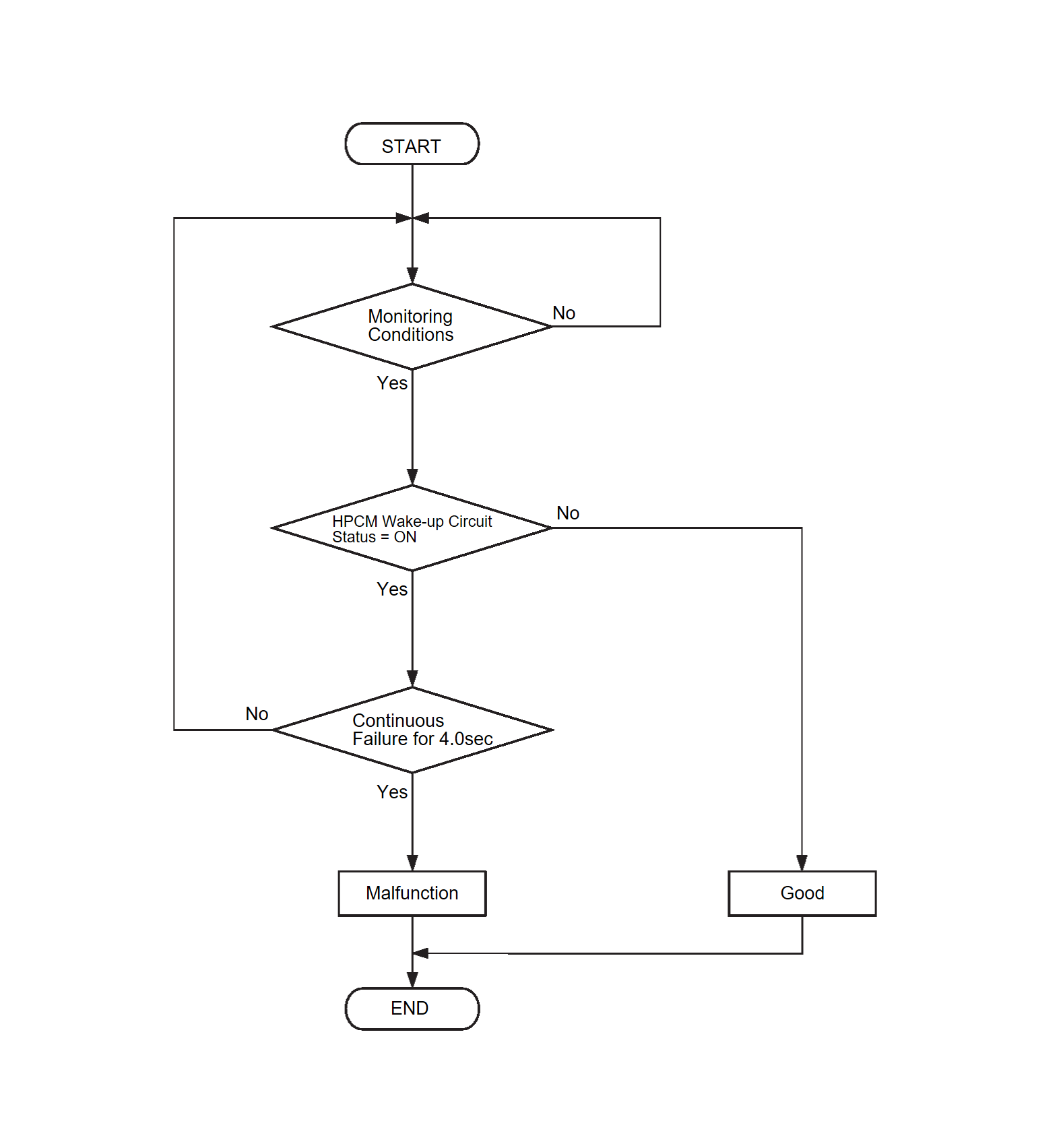DTC No. P1B10-11 HW low stiction diagnosis for waking priority ECU
MONITOR EXECUTION
Once per driving cycle
MONITOR EXECUTION CONDITIONS (Other monitor and Sensor)
Other Monitor (There is no temporary DTC set in memory for the item monitored below)
- Not applicable
Sensor (The sensor below is determined to be normal)
- Not applicable
DTC SET CONDITIONS
Check Condition
- BMU power supply voltage is more than 7.578 volts
- The vehicle status is in propulsion system active condition.
- PHEV-ECU wake-up circuit drive request: OFF
- Monitoring DTC No. P1B0F is completed.
Judgment Criterion
- PHEV-ECU wake-up circuit status is in ON condition for 4 seconds or more.
OBD-II DRIVE CYCLE PATTERN
- Refer to OBD-II Drive Cycle OBD-II DRIVE CYCLE
 .
.
TROUBLESHOOTING HINTS
- Damaged wiring harness and connectors
- Malfunction of the PHEV-ECU
- Malfunction of the BMU
DIAGNOSIS
Required Special Tools:
- MB992744: Vehicle communication interface-Lite (V.C.I.-Lite)
- MB992745: V.C.I.-Lite main harness A
- MB992747: V.C.I.-Lite USB cable short
- MB992748: V.C.I.-Lite USB cable long
- MB991223: Wiring harness set
- MB992006: Extra fine probe
1.Voltage measurement at drive battery connector (control wiring harness connector) (PHEV-ECU start request signal voltage)
(1) Disconnect the connector, and measure at the wiring harness side.
(2) Measure the voltage of the following.
- Voltage between the drive battery connector (control wiring harness connector) (terminal No. 20) and body ground
OK: Battery voltage
Is the check result normal?
2.Check of PHEV-ECU start request signal line between PHEV-ECU connector and drive battery connector (control wiring harness connector)
Check the following for short to ground circuit.
- Short to ground circuit between the PHEV-ECU connector (WKUP terminal) and drive battery connector (control wiring harness connector) (terminal No. 20)
Is the check result normal?
3.Test the OBD-II drive cycle.
(1) Carry out a test drive with the drive cycle pattern. Refer to OBD-II Drive Cycle OBD-II DRIVE CYCLE .
.
 .
.(2) Check the DTC.
Is the DTC set?
 Replace the PHEV-ECU (Refer to PHEV-ECU REMOVAL AND INSTALLATION
Replace the PHEV-ECU (Refer to PHEV-ECU REMOVAL AND INSTALLATION ). Then,
). Then, 
 The trouble can be an intermittent malfunction (Refer to General Information - How to Use Troubleshooting/Inspection Service Points, How to Cope with Intermittent Malfunctions HOW TO COPE WITH INTERMITTENT MALFUNCTIONS
The trouble can be an intermittent malfunction (Refer to General Information - How to Use Troubleshooting/Inspection Service Points, How to Cope with Intermittent Malfunctions HOW TO COPE WITH INTERMITTENT MALFUNCTIONS ).
).4.Check of other system data list
(1) Disconnect the drive battery connector (control wiring harness connector).
(2) Check the following PHEV-ECU data list item.
- Item No. 1110: Connection status signal from BMS
OK: OFF
Is the check result normal?
 Replace the PHEV-ECU (Refer to PHEV-ECU REMOVAL AND INSTALLATION
Replace the PHEV-ECU (Refer to PHEV-ECU REMOVAL AND INSTALLATION ). Then,
). Then, 
5.Test the OBD-II drive cycle.
(1) Carry out a test drive with the drive cycle pattern. Refer to OBD-II Drive Cycle OBD-II DRIVE CYCLE .
.
 .
.(2) Check the DTC.
Is the DTC set?
 The trouble can be an intermittent malfunction (Refer to General Information - How to Use Troubleshooting/Inspection Service Points, How to Cope with Intermittent Malfunctions HOW TO COPE WITH INTERMITTENT MALFUNCTIONS
The trouble can be an intermittent malfunction (Refer to General Information - How to Use Troubleshooting/Inspection Service Points, How to Cope with Intermittent Malfunctions HOW TO COPE WITH INTERMITTENT MALFUNCTIONS ).
).6.Drive battery control wiring harness check (PHEV-ECU start request signal line)
(1) Disassemble the drive battery (Refer to SERVICE PROCEDURE ).
).
 ).
).(2) Check the following wiring harness for short to ground circuit.
- Between the BMU connector (terminal No. 17) and the drive battery connector (control wiring harness connector) (terminal No. 20)
Is the check result normal?
 Replace the BMU (Refer to BATTERY MANAGEMENT UNIT (BMU) REMOVAL AND INSTALLATION
Replace the BMU (Refer to BATTERY MANAGEMENT UNIT (BMU) REMOVAL AND INSTALLATION ). Then,
). Then, 
7.Test the OBD-II drive cycle.
(1) Carry out a test drive with the drive cycle pattern. Refer to OBD-II Drive Cycle OBD-II DRIVE CYCLE .
.
 .
.(2) Check the DTC.
Is the DTC set?
 Retry the troubleshooting.
Retry the troubleshooting. The procedure is complete.
The procedure is complete.![[Previous]](../../../buttons/fprev.png)
![[Next]](../../../buttons/fnext.png)
